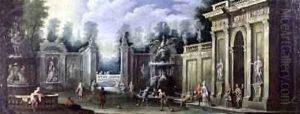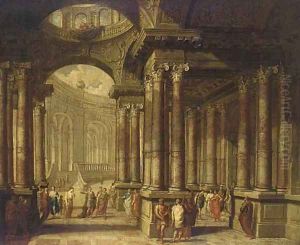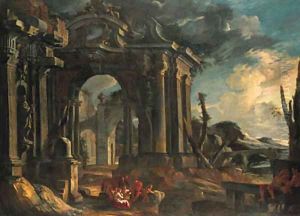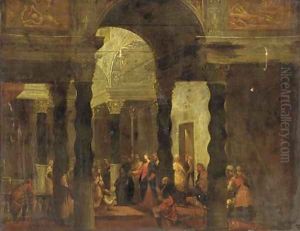Pietro (Il Mirandolese) Paltronieri Paintings
Pietro Paltronieri, also known as Il Mirandolese after his birthplace Mirandola, was an Italian painter during the Baroque period. Born in 1673, Paltronieri was active primarily in his native region of Emilia-Romagna, particularly in Modena. He is recognized mostly for his eccentric and unique approach to perspective, which earned him another nickname, 'Pietro dei Paesaggi' (Peter of the Landscapes), reflecting his specialization in capricci, or architectural fantasies, that often depicted ruins or ancient Roman architecture with whimsical and exaggerated perspectives.
Paltronieri's work was heavily influenced by the vedutisti, or view painters, of the 17th and 18th centuries, such as Giovanni Paolo Panini and Viviano Codazzi, who were known for their grand scenes of Rome’s historical architecture. However, Paltronieri's approach was more fantastical and imaginative compared to the more accurate representations of his contemporaries. His paintings often contained a blend of real and imagined elements, combining classical architecture with contemporary buildings from his time.
Despite his somewhat peripheral position in the major art centers of Italy, Paltronieri managed to establish a local following in Modena and nearby cities. His work was collected by local patrons and members of the Este court, who appreciated his unique interpretations of architectural vistas. Paltronieri’s paintings are characterized by a sharp contrast in light and shadow, a technique that enhances the dramatic effect of his distorted perspectives and contributes to the overall theatrical quality of his compositions.
Pietro Paltronieri continued to paint and contribute to the artistic landscape of his region until his death in 1741. Today, his works can be found in various Italian churches and collections, serving as examples of the Baroque fascination with illusion, perspective, and the blending of reality with imagination. While he may not have gained the widespread fame of some of his contemporaries, his distinctive style offers an important insight into the diverse range of artistic explorations that occurred during the Baroque period in Italy.



